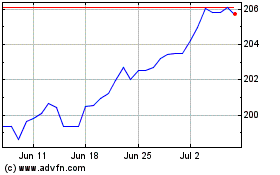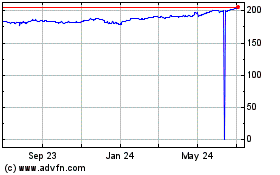Pound Falls As U.K. Consumer Inflation Remains Steady
June 13 2018 - 2:26AM
RTTF2
The pound slipped against its major counterparts in the European
session on Wednesday, as U.K. consumer inflation remained at a
one-year low in May.
Data from the Office for National Statistics showed that UK
inflation remained stable in May.
Consumer price inflation held steady at 2.4 percent, the lowest
since March 2017, and in line with expectations.
Month-on-month, consumer prices gained 0.4 percent in May,
matching economists' expectations.
Core inflation that excludes energy, food, alcoholic beverages
and tobacco, also remained stable in May, at 2.1 percent.
Separate data showed that input price inflation accelerated
more-than-expected to 9.2 percent in May from 5.6 percent a month
ago. Prices were forecast to rise 7.6 percent.
Likewise, monthly inflation advanced to 2.8 percent from 0.6
percent, and above the expected increase of 1.8 percent.
At the same time, output price inflation climbed to 2.9 percent
annually, as expected, from 2.5 percent. Month-on-month, prices
registered a steady increase of 0.4 percent, while economists had
forecast a 0.3 percent rise.
British house price inflation eased further in April to the
lowest level in just over a year.
The house price index climbed 3.9 percent year-over-year in
April, slower than March's 4.2 percent rise.
Investors also awaited monetary policy announcements from three
major central banks due this week.
The U.S. Federal Reserve is widely expected to raise interest
rates by 25 basis points when it ends its two-day policy meeting
later today.
On Thursday, the European Central Bank may outline plans for
ending its bond purchasing program.
The currency showed mixed trading against its major rivals in
the Asian session. While it held steady against the franc and the
euro, it rose against the yen. Against the greenback, it
dropped.
The pound dropped to an 8-day low of 1.3308 against the
greenback, after rising to 1.3375 at 5:15 pm ET. The pound is seen
finding support around the 1.32 region.
The pound depreciated to 1.3159 against the Swiss franc, down
from a high of 1.3205 hit at 3:00 am ET. The next likely support
for the pound is seen around the 1.29 level.
Data from the Federal Statistical Office showed that
Switzerland's industrial production and turnover increased in the
first quarter.
Industrial production advanced 9 percent on a yearly basis in
the first quarter. Production climbed 7.1 percent in January, 11.3
percent in February and 11.2 percent in March.
Pulling away from an early high of 0.8779 against the euro, the
pound declined to 0.8823. On the downside, 0.90 is possibly seen as
the next support level for the pound.
Having advanced to 147.90 against the yen at 11:15 pm ET, the
pound reversed direction and dropped to 147.21. If the pound falls
further, 146.00 is likely seen as its next support level.
Looking ahead, U.S. PPI for May is scheduled for release in the
New York session.
At 2:00 pm ET, the Fed announces its decision on interest rates.
The Fed is widely expected to raise the federal funds rate by a
quarter point to a range of 1.75 percent to 2 percent.
Sterling vs Yen (FX:GBPJPY)
Forex Chart
From Mar 2024 to Apr 2024

Sterling vs Yen (FX:GBPJPY)
Forex Chart
From Apr 2023 to Apr 2024
